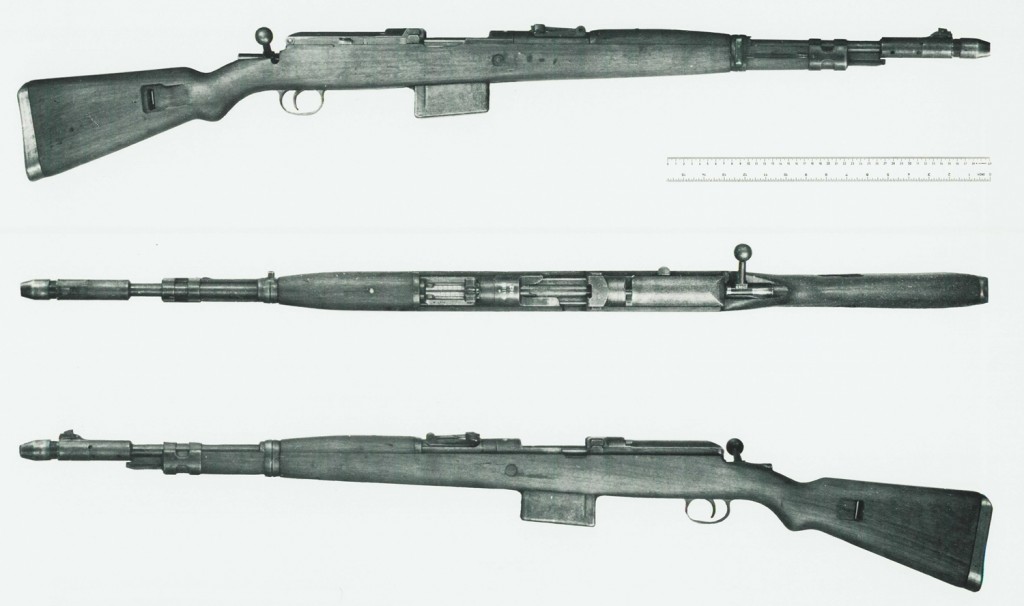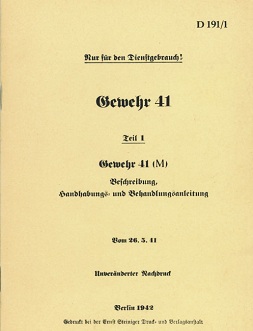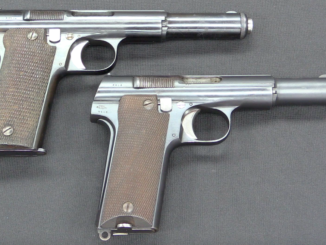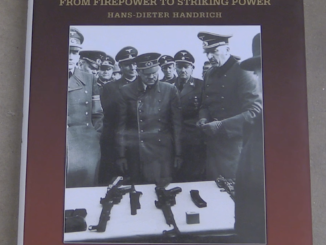Last week, we posted a video on the Gewehr 41(W), which was the first really mass produced German self-loading combat rifle. Well, when the Heereswaffenamt (German ordnance department) requested designs for what would become the G41, both Mauser and Walther submitted samples. The Walther version was ultimately accepted, but intially several thousand of both types were ordered for testing and evaluation. The G41(W) was a complicated affair, but the G41(M) was even worse.
Both designs for the G41 used virtually identical nose caps and gas pistons of the Bang type (the two companies probably collaborated on that element of the design). The mechanical similarities end there, though. The G41(M) connecting rod pushes against a block under the barrel and in front of the receiver, which in turn is connected to an addition pair of bars (one on each side of the receiver) that push on the bolt carrier. This was done to comply with the HWaA requirement that there be no moving parts on the top of the rifle (Walther ignored this requirement). The bolt on the G41(M) was of a rotating type, with two locking lugs on the front and a spiral cam rail machined into its exterior (similar to a Ross or Schmidt-Rubin rifle). This cam interacted with a matching groove cut in the bolt carrier, so when the bolt carrier was pushed backwards upon firing, it would rotate and unlock the bolt and then pull it rearwards. This operating system required no fewer than eight different moving parts (plus springs) just for cycling. For comparison, the AK uses two. For another measure of complexity, the G41(M) has eighteen different springs.

You will probably notice the bolt handle in that photo, and how it looks remarkably like the handle of a K98 or other bolt action rifle. This was another feature from Mauser to comply with the HWaA’s old-world requirements. They had decreed that the rifle must function using the same manual of arms as the K98k in case of malfunction – so Mauser used a bolt handle that had to be rotated 90 degrees and pulled back to manually cycle the gun (instead of a simpler fixed handle on the bolt carrier, like the G41(W) used).
The G41(M) was manufactured in 1941 and 1942 (mostly 1942), and assembly of rifles continued until March of 1943 (or possibly a little later). Mauser was contracted to build 15,000 of them, and it appears that the contract was either fulfilled or very close to fulfilled. Production was slow because the company was heavily involved in building K98k rifles. The Walther version of the G41 was formally adopted on December 29th, 1942, and at the point if not earlier, company officials knew that additional G41(M) rifles would not be purchased.
In the field, the G41(M) proved unpopular with troops. In addition to being exceedingly complex and susceptible to fouling and malfunction, it was a long, heavy (11.5 pounds), and poorly balanced rifle. Captured SVT-40 Tokarev rifles were much preferred, and most of the G41(M)s ended up in the hands of second-line soldiers. The vast majority were lost or destroyed in Russia, and very few remain in collections today.
We are happy to say that we found a copy of an original German G41(M) manual, which you can download form the G41(M) page in the Vault or right here. Unfortunately the illustrations are small and copied poorly, but the text will be interesting to anyone who can read German script.





What you very fittingly describe as Heereswaffenamts old-world, backwards oriented requirements and the embarassing Mauser flop that resulted from them, should be kept in mind when today it is required that any new weapons should have the same controls as the AR-15 types.
Very true! Similarity in training is good, but as the G41(M) shows, it can really hamper innovation.
Well, they had even before 1941 two quite decent self-loading rifles in hands: Czech ZH-29, and Polish Kbsp wz.1938M. Both chambered for 7.92x57mm…
Yes, but neither one was formally adopted by the Wehrmacht.
Interestingly, autonomous Czech self-loading rifle developent continued under German occupation (and, I presume, supervision), yielding much better results than the German own efforts…